IT Project Discovery Phase: What's That, and What Does It Do?
Various fields of projects require a discovery phase to pave the way for successful implementation. In this article, we'll delve into IT projects and discuss the nuances of the discovery phase in this domain, exploring scenarios where a discovery phase becomes indispensable.
- Purpose of the Discovery Phase
- Deliverables of the Discovery Phase
- Is the Discovery Phase Essential?
- Benefits of the Discovery Phase
- The Discovery Phase in Software Projects
- The Discovery Phase in Firmware and Hardware Development
- The Discovery Phase in IoT Projects
- Our Approach to the Discovery Phase
- Conclusion
Purpose of the Discovery Phase
Each project is unique and demands a tailored approach. How can you identify the best strategy to bring your product to life? What methodology aligns perfectly with your idea? The discovery phase exists to address these critical questions.
This initial stage sets the tone for the project's success. Much of the project's outcome hinges on the insights gained during this phase.
Here, developers assess their capabilities, requirements, and the efforts needed to achieve the desired goals. Gathering essential project requirements is a key focus.
The ultimate aim is to create a product that fulfills end-user expectations. The beginning stage involves planning how to allocate time and funds effectively. The outsourcing firm follows this plan throughout the project, ensuring transparency and clarity for the client.
While the discovery phase is unique to every project, some common factors influence its structure:
- Company's engagement in the project. The duration and scope of the discovery phase depend on the project's starting point. It could be an initial evaluation of your idea, a focused analysis of a specific project segment, or a reevaluation of prior work.
- IT services involved. The significance of the discovery phase varies across different services. It helps define critical aspects of your project. For instance, you might learn whether certain changes or additions impact software, hardware, machine learning, IoT, or firmware development. Each service has its own set of challenges and flexibility levels. Hardware, IoT, embedded software, and firmware tend to be less adaptable than software or machine learning solutions, making any modifications costly and complex.
- Budget considerations. Many clients view the discovery phase as an additional expense, even though it is a crucial step. However, with a limited budget, the discovery phase can help optimize resource allocation.

Despite the differences in projects, initial steps are generally similar, laying the groundwork for subsequent design and development:
- Clarify the client's vision for the product;
- Align the client's expectations with user needs;
- Conduct preliminary technical expertise to confirm the team's capabilities.
This process can be time-consuming and costly, yet it is vital for the project's success.
Deliverables of the Discovery Phase
The outcome typically includes a discovery phase report outlining possible approaches, system mock-ups, proofs of concept, and technical documentation.
Primarily, the discovery phase report contains key research findings about the project and recommendations for specific components of the solution. With this report, the client gains confidence in receiving a product with the required characteristics within the allocated time and budget.
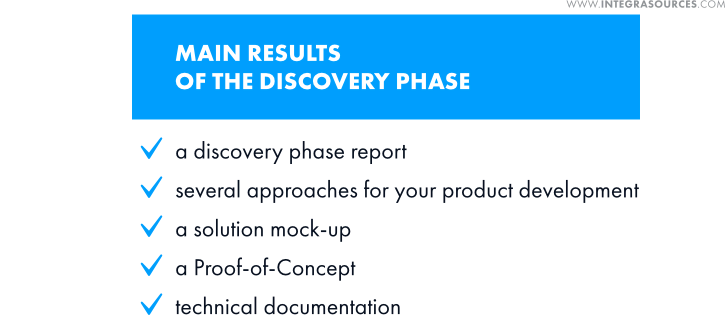
Is the Discovery Phase Necessary?
The discovery phase is one of the most important steps in product development, yet it is often misunderstood by clients.
Many clients view it as a necessary but costly step, while others see it as a waste of money and try to skip it altogether.
However, the discovery phase is designed to uncover potential pitfalls, minimize risks, save time and money, and identify the best approach for development.
Skipping the discovery phase can lead to unforeseen challenges in the development process:
- Ongoing expansion of the development cycle;
- Rising costs;
- Blurred deadlines and delayed launches;
- Failure to meet expected outcomes.
Benefits of the Discovery Phase
The discovery phase provides a strong foundation for building your product and streamlining related business processes. Its outcomes ensure a well-planned path for implementing your idea and help save both time and budget.
Here are the benefits you can expect upon completing the discovery phase:
- A structured and transparent product development process;
- Your development team is aware of potential challenges and knows how to overcome them;
- Your budget for product development remains secure, thanks to minimized risks that help avoid unnecessary expenses and shorten the time between development and launch;
- Alternative ways of creating your product are identified;
- A mock-up or proof of concept that visualizes your future product, helping you define possible changes and ensuring alignment with your target audience’s interests and expectations.
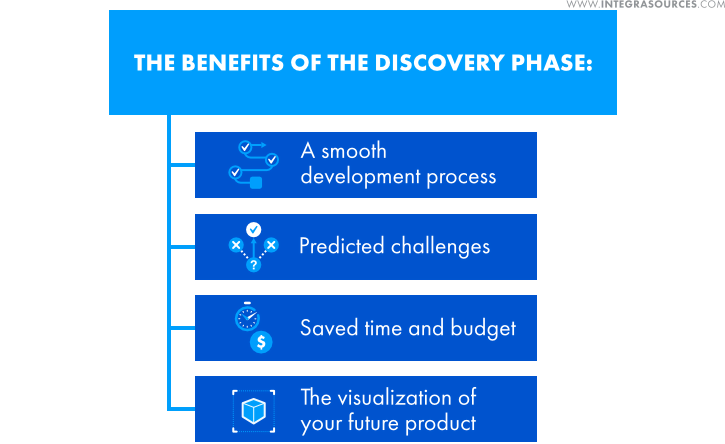
In short, the discovery phase bridges the gap between your idea and its execution. Let’s explore what makes this bridge strong and reliable for various types of projects.
The Discovery Phase in Software Projects
The nuances of the discovery phase vary depending on the project type. For example, the software discovery phase differs significantly from the hardware discovery phase in terms of duration, results, analyzed aspects, team composition, tools used, and cost.
Software Discovery Phase
Let’s discuss the discovery phase for software and machine learning projects.
First, it’s crucial to gather all necessary business requirements. This allows software developers to grasp the overall concept of the software product. Both the client and the technical team should focus on essential details for implementing the software under consideration. These include:
- User groups;
- Post-development software usage;
- Data processed by the software;
- Output generated after processing;
- User stories and use cases.
These elements form the foundation of the overall framework the software developers will follow. Next, the collected information is analyzed and validated.
This process culminates in a requirement specification document that outlines the nature of the software product and the functionality required to meet stakeholder demands.
Upon completing the software discovery phase, you’ll receive the following deliverables:
- A mock-up or proof of concept for the most suitable UX design;
- A mock-up or proof of concept for the whole software solution or a part studied in the discovery phase;
- A prepared requirement specification document;
- Lists of use cases and user story descriptions.
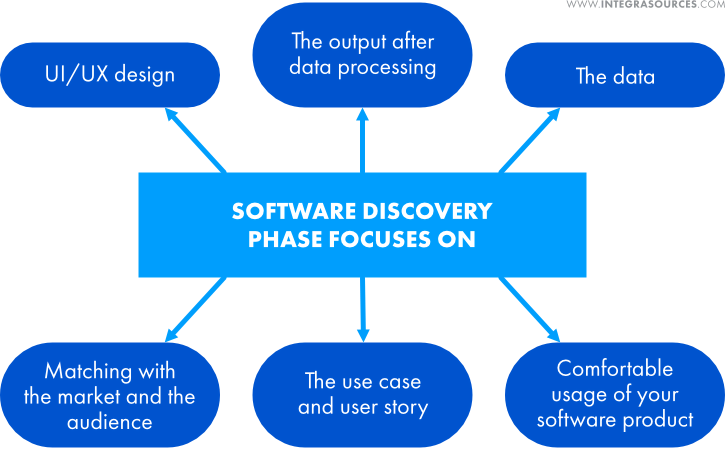
For instance, we conducted the discovery phase for a project involving the development of LED matrix display software for freeway monitoring and visualizing weather conditions, traffic jams, and road signs for drivers.

Our client wanted users to monitor this information remotely and asked us to determine whether a mobile app or a web app would be better. We analyzed the sensors and wireless protocols used for the LED displays, compared the costs of building a mobile app versus a web app, and assessed user comfort with each option.
After thorough research, our Integra team concluded that a web application was the optimal choice for implementing this feature. The reason is that LED displays should work with the UTMC protocol for connecting to the Intelligent Transportation System. A web portal is the most cost-effective way to implement this feature, enabling real-time visualization of data collected from the LED displays and their sensors.
Another crucial aspect in software development is use cases and user stories, which our engineering team takes seriously. For example, we conducted the discovery phase for the software part of a project involving the development of a Wi-Fi-enabled controller for hot tubs.
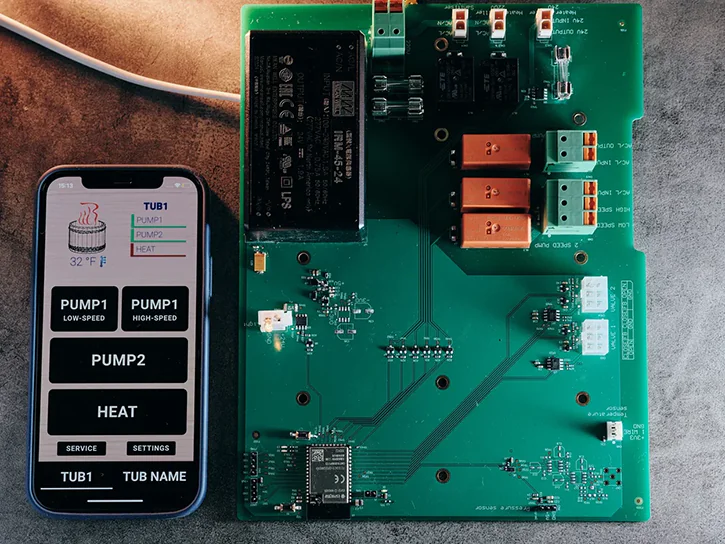
During the discovery phase, we designed a UI/UX for an iOS and Android mobile application allowing users to control hot tub sensors and pumps remotely. The mobile app connects to multiple sensors and hot tub components, and our client wanted the app to be intuitive and user-friendly. Therefore, we outlined the most comfortable process for using the app and described the user experience.
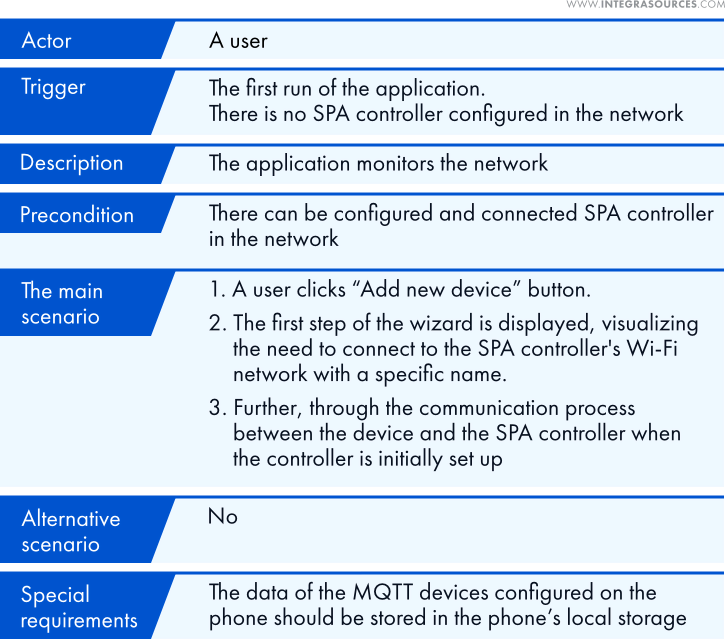
Machine Learning Discovery Stage
In building machine learning and AI-driven solutions, identifying the right dataset and clearly stating the problem your machine learning solution should solve are crucial.
During the discovery stage of a machine learning project, we should uncover the following critical aspects:
- The main objective of the discovery phase;
- Target features: algorithm accuracy, operation speed, integration with other software;
- Input data and its availability;
- Dataset availability;
- The problem the future product can solve;
- Potential improvements to the machine learning solution.
These points are specifically formulated for machine learning projects. However, we should also incorporate questions from the software discovery phase. Our Integra team developed a camera system based on computer vision algorithms for detecting falls among the elderly. This is a complex solution, and we recommended starting with the discovery phase to determine project feasibility.
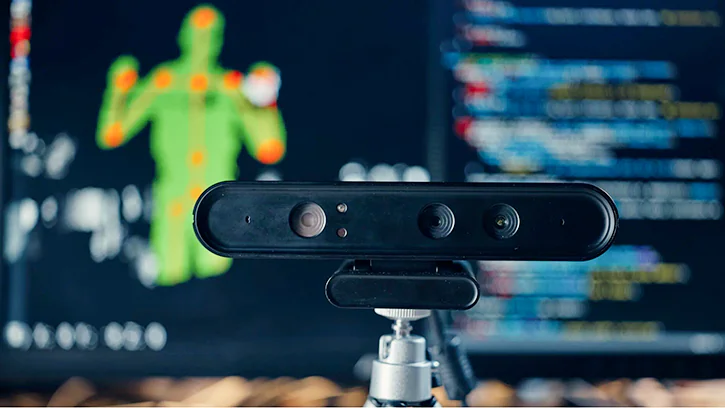
During the discovery phase, we selected the appropriate amount of depth camera sensors and defined the type of data necessary for training a machine learning model to track human movements and recognize falls.
One of the main outcomes of this discovery phase is the feasibility of the communication system for this solution. We determined that it is possible to implement a computational unit for collecting data from all cameras and sending signals to caregivers in case of a fall. Thus, upon completing the discovery phase, we created a proof of concept for a comprehensive solution for elderly care.
The Discovery Phase in Firmware and Hardware Development
It’s important to note that firmware and hardware development is less flexible than software implementation. Making changes to hardware or firmware solutions can lead to complete hardware redesign, costing both time and money.
This characteristic underscores the importance of the discovery phase for projects involving device and embedded system development, as well as low-level programming.
Before moving forward with development, it’s crucial to define the following:
- Design restrictions for your solution;
- Problems your hardware or firmware product solves;
- Market you’re targeting—industrial hardware or consumer electronics;
- Feasibility of creating your hardware or firmware product using existing technologies;
- Suitable technologies and approaches for product development;
- Changes that could impact future development;
- Features that could enhance performance;
- Challenges in developing certain parts of your hardware or firmware;
- Software your device or system must communicate with.
The hardware and firmware discovery phase aims to identify these key constraints in your hardware solution development and firmware implementation.
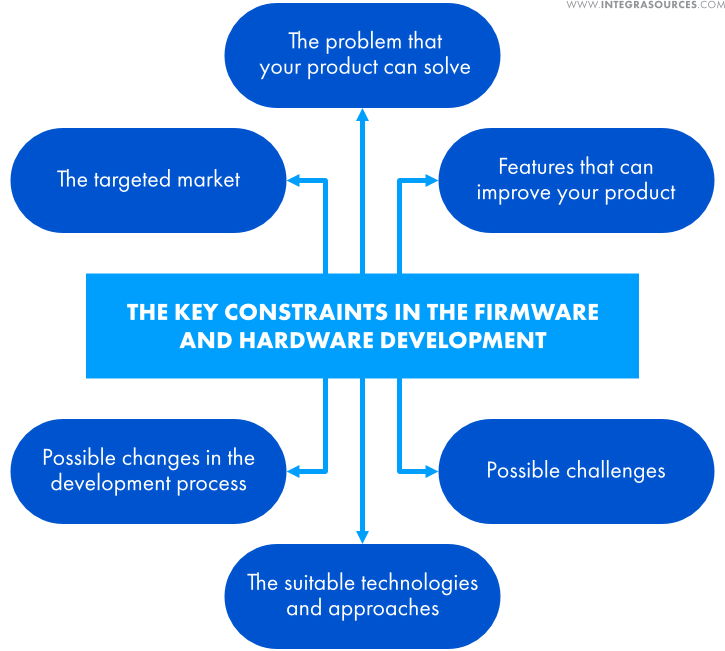
Let’s examine one of our previous projects that began with the discovery phase. Our team was tasked with conducting a discovery phase to find possible solutions for developing custom capacitive keyboard electronics and determining the most suitable components for building this product.
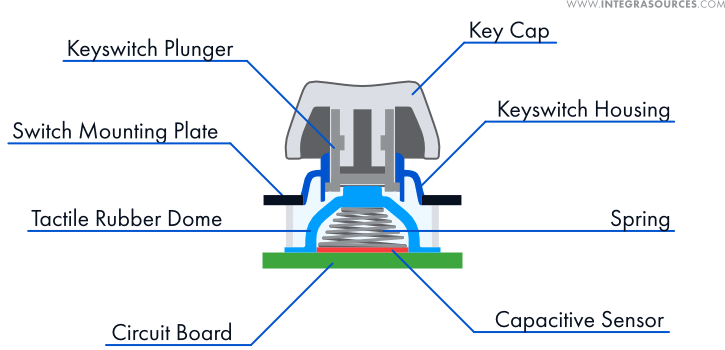
The customer’s requirements for the keyboard included capacitive sensing, detection of spring collapses above electrode pads on the PCB, simultaneous detection of all pressed keys, and compatibility with the QMK keyboard.
Our Integra team explored various approaches for measuring capacitance and determined that applying a high-frequency signal to columns one by one, amplifying each row signal, and performing amplitude demodulation and peak detection were necessary.
We found two ways to achieve this: 1) using discrete components and 2) using capacitive sensor ICs.
We simulated the first solution and suggested balancing the number of channels with the keys polling speed. This proved to be the best approach, fulfilling all the customer’s requirements for the capacitive keyboard product.
The second solution required using two sensor ICs for creating this capacitive keyboard. However, after completing our research, we realized that using sensor ICs did not provide accurate sensing.
As a result, we provided the customer with a detailed report describing these two solutions. The customer chose the first solution with discrete components because it was cost-efficient and allowed them to achieve all their goals successfully.
The Discovery Phase in IoT Projects
IoT solutions development typically involves building software, firmware, and hardware components, making it a 3-in-1 system. This means all these parts are interconnected, and changes in one component will affect the others.
An IoT system consists of interconnected IoT devices, sensors, databases, software applications, web services, and other network components. Secure and stable communication among these components is essential for an IoT solution. Therefore, each component should be efficient, and you should choose high-quality ones.
Updating, adding or removing features, or replacing a specific component can lead to significant challenges and may require a complete redesign of the entire IoT system. This can increase time, budget, and resource expenditure. However, starting your IoT project with a discovery phase can help you define suitable components, features, and potential challenges early on.
Upon completing the IoT project discovery phase, you’ll receive a report with the following deliverables:
- A detailed description of the purpose, behavior, and requirements of the IoT system;
- A list of physical and virtual units, devices, sensors, and services necessary for IoT solution development;
- Specifications of information in your IoT system;
- A list with descriptions of suitable communication and data storage options;
- A mock-up or proof of concept of your entire IoT solution or the part studied in the discovery phase;
- Possible solutions and approaches for building your IoT system.
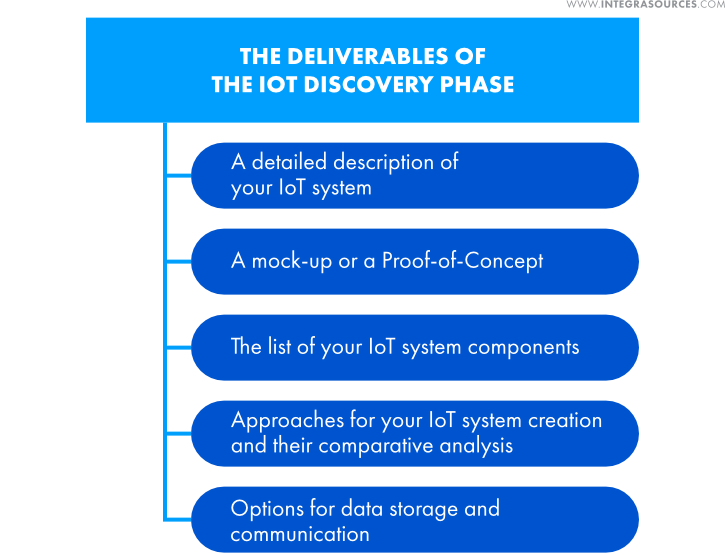
For example, our Integra team conducted a discovery phase for an IoT system for monitoring and controlling recreational vehicle equipment remotely.
The customer asked us to select the right components (MCU and sensors) for a BLE gateway device, define compatible remote services for data storage and processing, and find suitable options for power supply.
We analyzed the customer’s requirements for this monitoring IoT system and identified cost-efficient components with the desired functionality. For the software part of the IoT system, we worked on a mockup of an IoT software solution with mobile and web applications, cloud services, and a dashboard.

The results of this discovery phase helped our customers choose the right approach for their project development. This IoT product is now nearing its launch.
Our Approach to the Discovery Phase
Our Integra Sources team uses agile methodologies in conducting the discovery phase. This allows us to examine your solution from every angle and find the most effective approach for its development.
Our agile discovery phase template includes several stages:
- Gathering the client’s requirements for the functionality, cost, features, and other characteristics of the future product or its part;
- Involving developers with the required technology stack in the discovery phase team;
- Doing research to answer the client’s questions and define approaches for building a solution or its part;
- Building a mock-up or proof of concept;
- Creating a discovery phase report with detailed results and presenting them to the client;
- Developing a roadmap with timelines, budget, milestones;
- Agreeing on next steps.
Depending on the project complexity, the discovery phase can require from 40 to 200 man-hours. Our discovery phase team usually includes a project manager, several developers, a tech lead, and the client’s team. However, for complex solutions or innovative products, we involve more engineers in the discovery phase.

Our team has extensive experience in researching and developing software, machine learning, firmware, hardware, and IoT projects, guiding them from inception to fully functional products. If you have an idea to check for feasibility, feel free to reach out to us.
Conclusion
Developing a new product or implementing a new feature can be a challenging journey. However, if planned well, this journey will lead to a smooth and transparent development process for you and your technical team.
The primary purpose of the discovery phase is to safeguard the future of your idea and protect you from potential risks.
Straight Arm Aerial Work Platform,Used Bucket Lifts,Used Aerial Platform,Aerial Work Platform
XCMG Global Circularity Business Center , https://www.usedmachinemkt.com